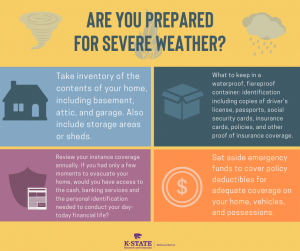Preparing for flooding and severe weather
Prepare Yourself for Severe Weather
Would you be prepared to take action if your property was hit by a tornado, overcome by
a flood or destroyed by a fire? Many people have installed smoke detectors, fire alarms,
and dead bolt locks in their homes and stocked extra food in the pantry, but there is more
to preparing. To be prepared, you should also have a household inventory, check your
insurance coverage, and prepare a grab-and-go box.
A household inventory is an itemized list of the contents of your home, including
basement, attic, and garage. It could also include a list of the contents of storage areas,
such as sheds or other small buildings on your property. If you have a rented storage unit
off-site, consider completing an inventory for that, as well. An accurate inventory is a
necessity whether you are a homeowner or a renter.
The purpose of insurance is to cover major losses. Review your insurance coverage at
least annually. You may want to conduct a face-to-face review with your insurance agent
every other year. Make sure you have adequate coverage on your home, vehicles, and
possessions. If at all possible, set aside emergency funds to cover the policy deductibles.
Keep the name of the agent(s) and policy number in your grab and go box. Consider
purchasing the other types of insurance, such as disability and/or life insurance for the
wage earner.
If you had only a few moments to evacuate your home, would you have access to the
cash, banking services and the personal identification needed to conduct your day-to-day
financial life? Consider keeping the following items in a secure place in your home, in a
waterproof, fireproof container that can be taken with you at a moment’s notice:
Identification and other key documents that may be needed to restore your financial
records, including copies of your driver’s license, passports, social security cards
insurance cards, policies, or other proof of insurance coverage.
This list of items to pack is much longer and you can find the full publication about
taking steps ahead of disaster at: https://bit.ly/2vck8EY
For additional information, contact the Wildcat Extension District, Crawford County,
620-724-8233, Labette County, 620-784-5337, Montgomery County, 620-331-2690.
For more information, contact Kylie Ludwig, Entrepreneurship and Financial
Management Agent, ludwigk@ksu.edu or (620)784-5337
Kansas Department of Agriculture- https://agriculture.ks.gov/news-events/nebraska-flooding-disaster-recovery-resources
Disaster Relief and Emergency Assistance- https://www.hud.gov/states/kansas/library/disasterrelief
Floods And Your Farm- http://www.prep4agthreats.org/Natural-Disasters/floods-and-farm
Family Crisis- https://cropwatch.unl.edu/2019/coping-stress-during-crisis
Stored Grain- https://www.extension.iastate.edu/sites/www.extension.iastate.edu/files/files/flooding%20and%20stored%20grain.p
Additional information for specific counties:
CRAWFORD
https://www.crawfordcountykansas.org/emergency-management.html
https://www.facebook.com/crcoksem/
NEOSHO
http://www.neoshocountyks.org/index.php/sheriff/emergency-management
https://www.facebook.com/nocoksemergencymanagement/
WILSON
https://www.facebook.com/WCEMKS/
LABETTE
https://www.labettecounty.com/department/index.php?structureid=3
MONTGOMERY
https://www.facebook.com/MCKYEMA/
